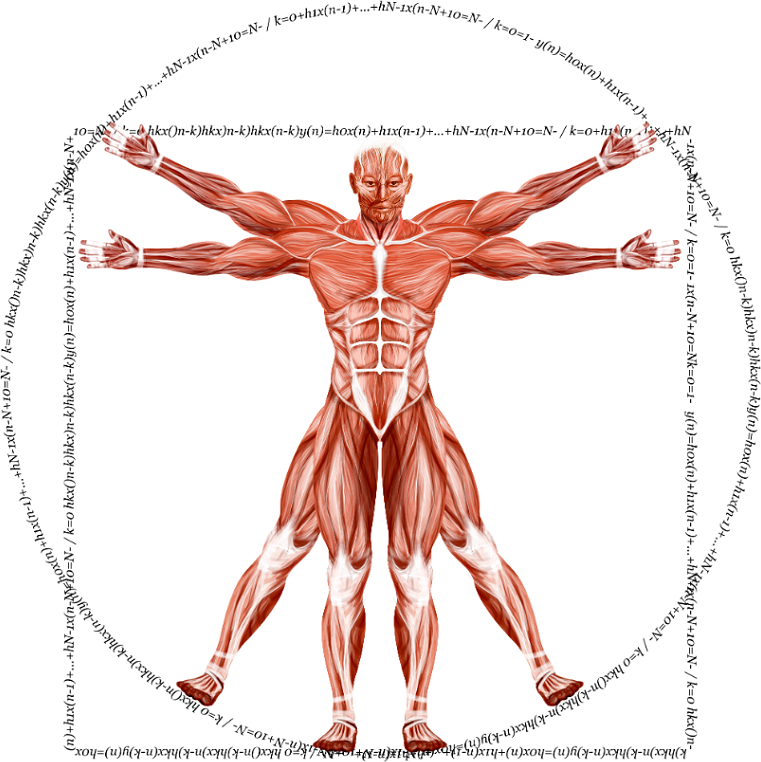The Perfect Number of Exercises for Your Muscles
Quality over quantity: Optimizing your exercise selection for maximum muscle gain
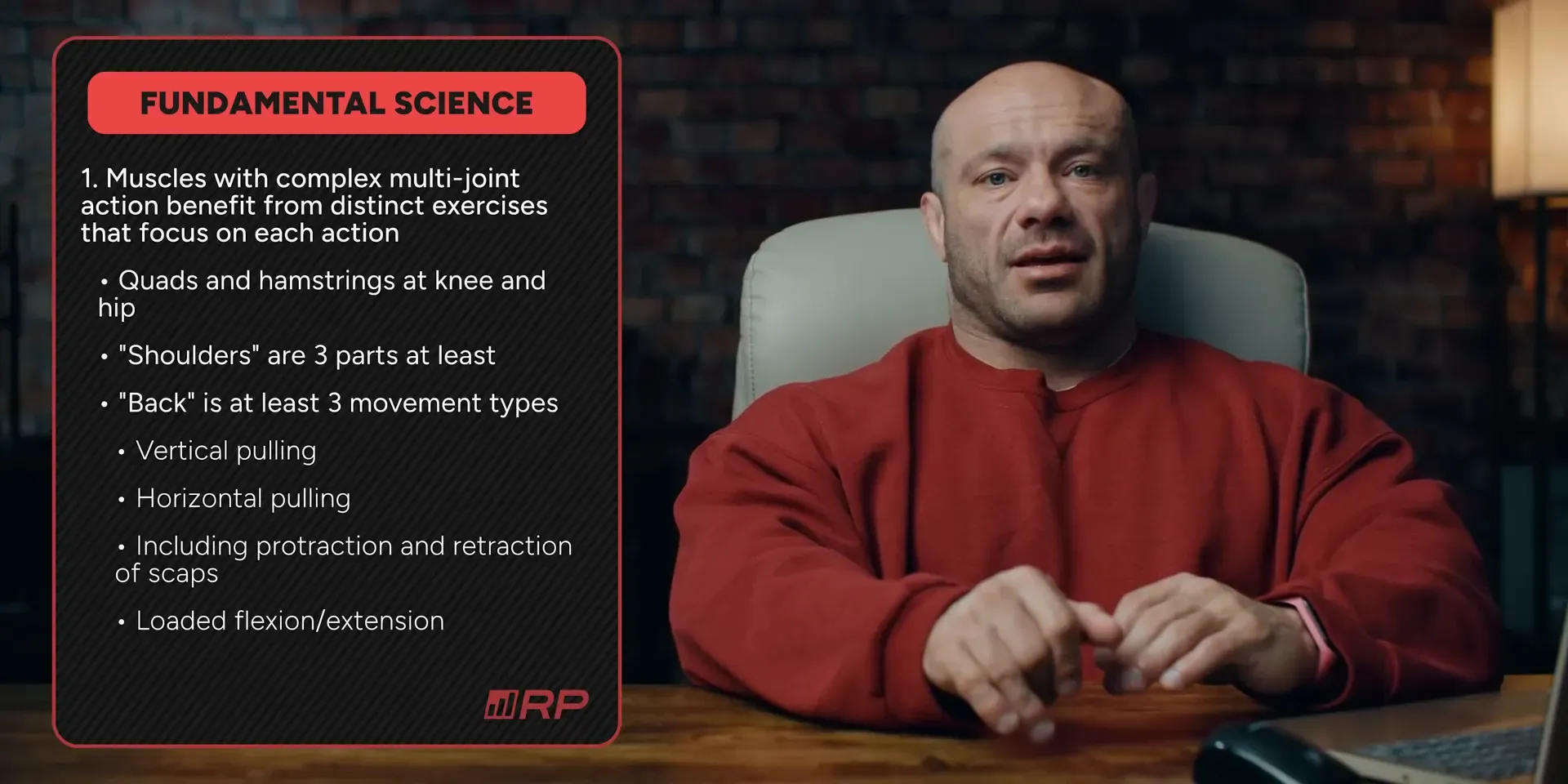
Key Takeaways
- Focus on 2-4 exercises for optimal growth
- Understand the anatomy of muscles to select effective exercises
- Rotate exercises periodically to maintain progress
- Prioritize quality over quantity in your workouts
- Individual responses can vary, so adjust based on your experience and results
In the quest for optimal muscle growth, the number of exercises included in your routine can significantly impact your results.
In this post, we review and critique a lecture by Mike Israetel exploring the science behind choosing the right number of exercises, common mistakes, and practical recommendations to enhance your training efficiency.
In a Nutshell—Dr. Mike Israetel on Choosing Exercises for Growth
‧ Focus on 2-4 exercises for optimal growth
‧ Stick to a few well-chosen movements that target the muscle adequately
‧ Use compound movements where possible (they engage multiple muscle groups and save time)
Remember, consistency and smart choices are key to seeing results. Adjust your exercises and rep ranges to keep things fresh, but focus on mastering a few core exercises.
Fundamental Science of Muscle Training
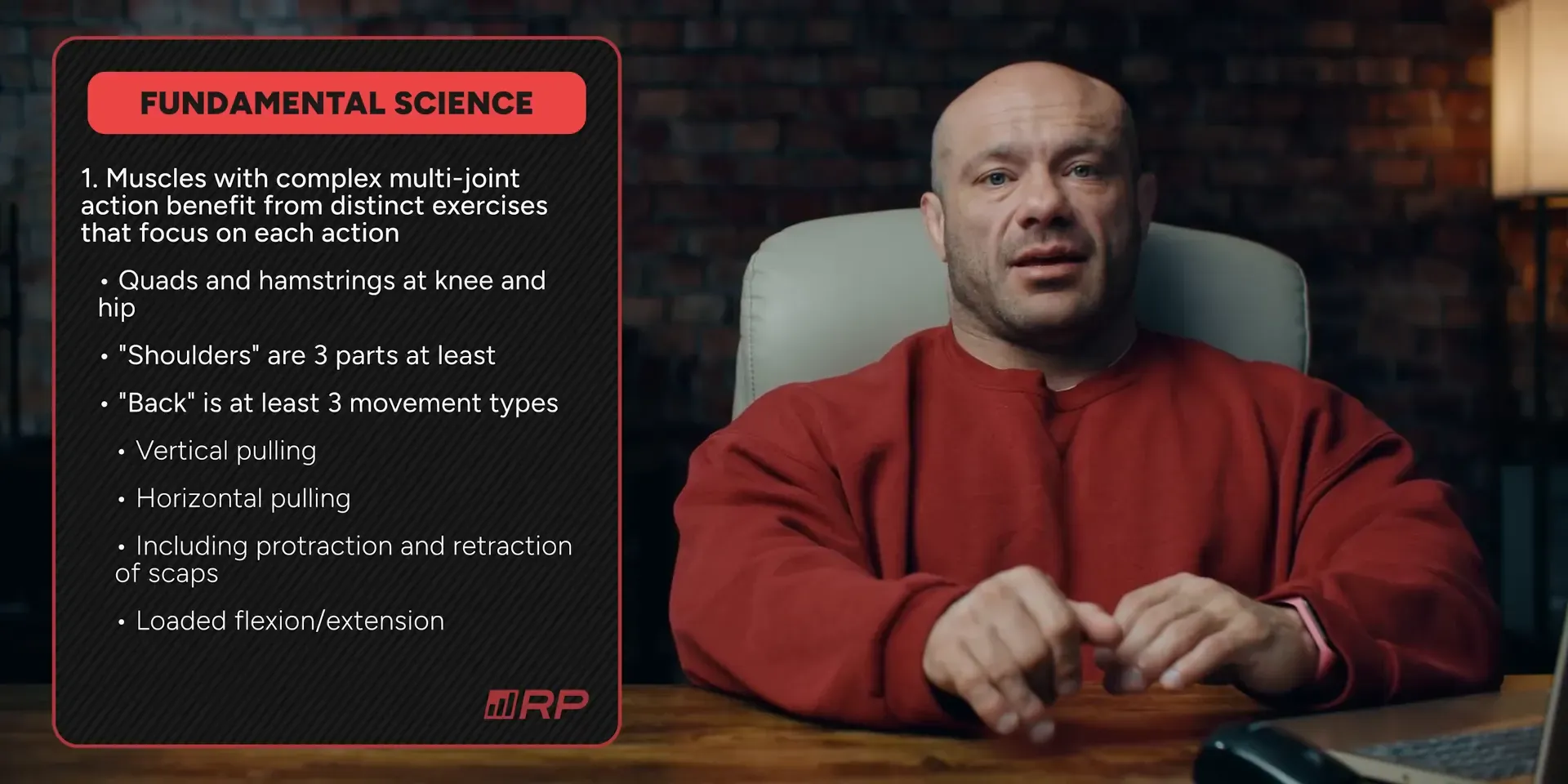
Understanding muscle training starts with the basic science behind it. Not all muscles are created equal. Some muscles, particularly those with complex multi-joint actions, can benefit from diverse exercises. This is because they have different functionalities that require multiple angles of attack.
Take the quads and hamstrings, for instance. Both work at the knee and hip. If you only do leg presses for your quads, you're missing out on the middle part of your quad, the rectus femoris. This muscle is only activated by specific movements like sissy squats or leg extensions.
Hamstrings, too, need attention. If you solely focus on leg curls or hip hinges, you're not fully engaging the muscle. Thus, including a variety of movements is essential for comprehensive muscle growth.
Another example is the shoulder muscles. The anterior and posterior deltoids oppose each other. There’s no single exercise that targets both effectively. The side delts require their own specific approach. So when you think about shoulder exercises, consider this complexity.
Moreover, the back is a complex muscle group. It involves vertical pulling, horizontal pulling, and spinal flexion and extension. If your routine only includes pull-ups, you're not training your entire back. A well-rounded approach is crucial for optimal muscle engagement.
Understanding Muscle Functionality
Most muscles, however, don't require more than one or two exercises per session for optimal growth. Typically, muscles grow best with four to eight working sets per session. If you're targeting your quads with two sessions a week, four to eight sets of quadriceps work is ideal.
This means if each exercise takes four sets, you're looking at two exercises per session. Utilizing four exercises for one muscle group in one session creates redundancy and can lead to diminishing returns.
Furthermore, you don't need more than two to four exercises per week for optimal muscle growth. It's beneficial to train most muscles two to four times weekly. This allows for different exercises each time, which keeps your routine fresh and effective.
The Importance of Variation
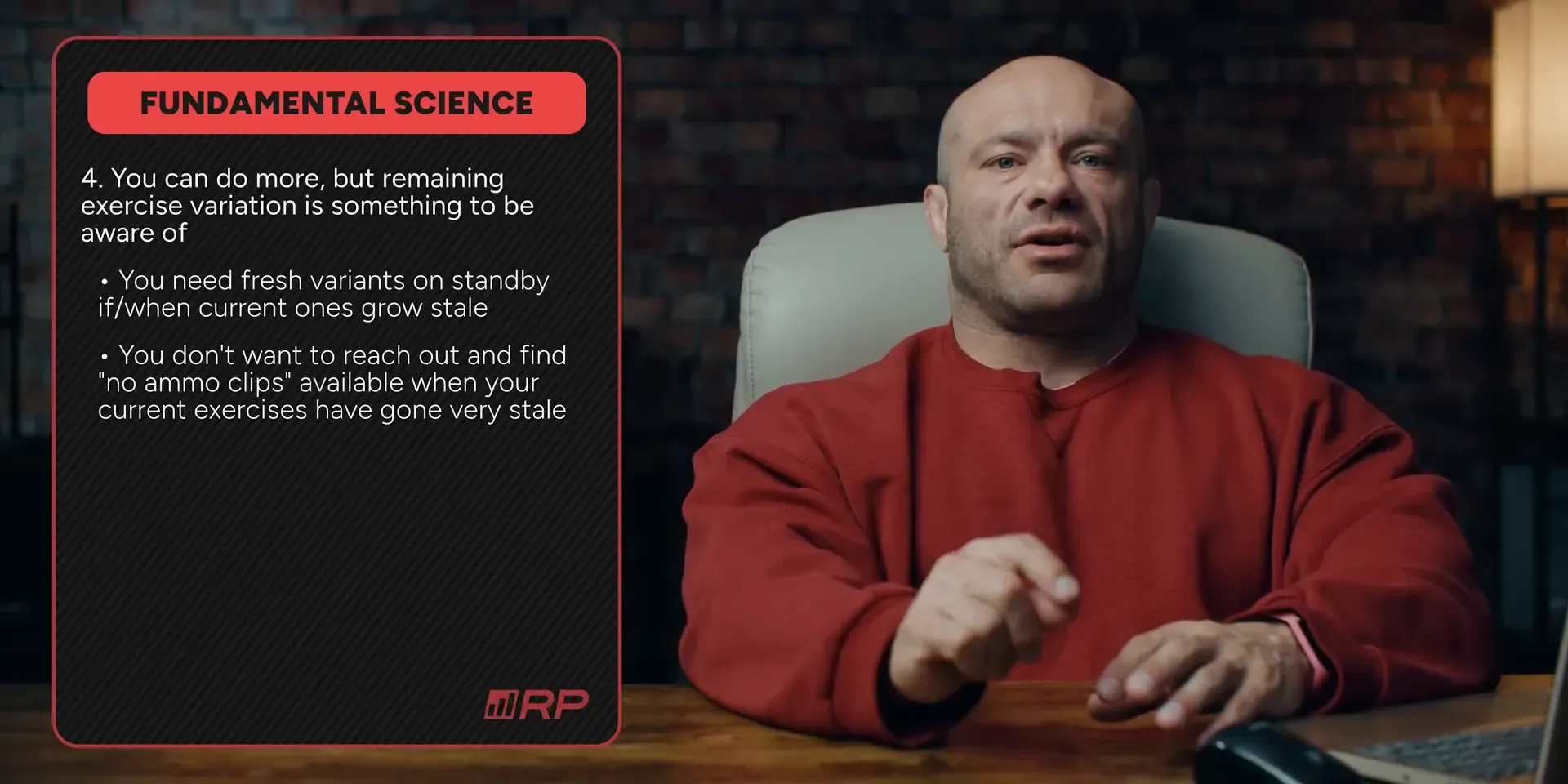
Variation is critical in your training. If you exhaust all your exercises in a short span, you risk losing effectiveness. Imagine using all five of your best quad exercises in one week. What do you have left when those become stale? You might need to revert to exercises you dislike, which can hinder your progress.
To avoid this, use two to three exercises at a time and cycle through them. This way, you can keep your workouts stimulating and effective. You can rotate exercises to maintain freshness and efficacy over several months.
When choosing exercises, cover all main muscle functions. For instance, when training the chest, include both flat and incline pressing movements. This approach ensures that you’re targeting all areas of the muscle effectively.
Optimal Number of Exercises per Session
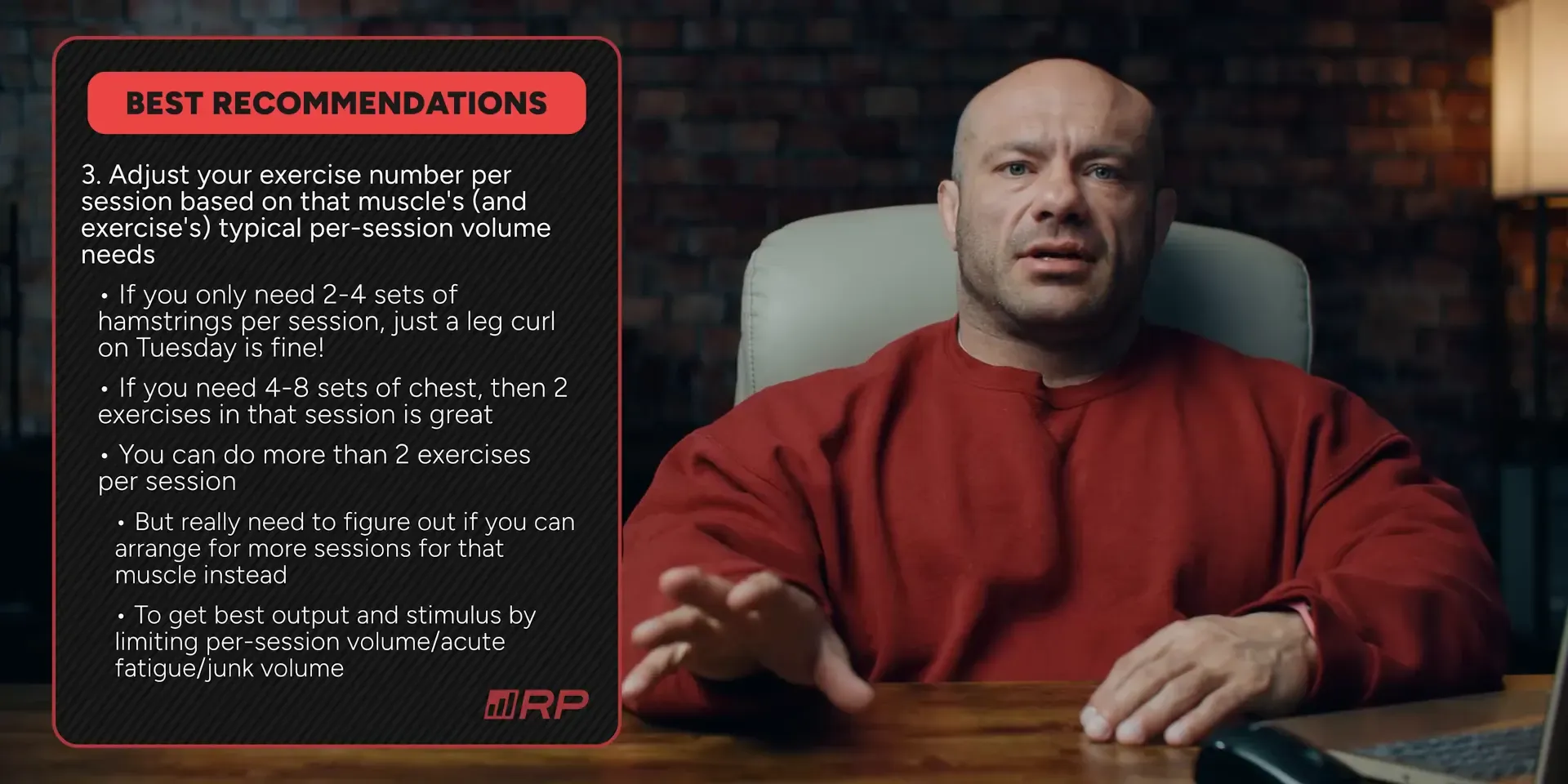
When it comes to the number of exercises, consider how many sets you need for any given muscle in a session. Think of exercises like plates at a dinner. If you're stopping by for a quick meal, one plate suffices. But for a feast, you’ll need several plates to accommodate all the food.
If you plan to do four sets for a muscle, one exercise is generally enough. However, if you're training a complex muscle group like the back, you might need two or three exercises to reach your set goals.
It's essential to balance your routine. Instead of cramming all your exercises into one session, consider spreading them across multiple days. This not only enhances training quality but also helps manage fatigue better.
Recommendations for Exercise Selection
When selecting exercises for your weekly routine, aim to cover all major muscle functions. For example, when working on hamstrings, combine hip hinge movements like deadlifts with leg curls. This combination ensures comprehensive muscle engagement.
In a muscle gain phase, it's not necessary to target every part of the muscle every week. If you're focusing on upper pecs, you might prioritize incline presses for several months without worrying about lower pecs.
Additionally, try to incorporate distributed compound movements. These compound lifts engage multiple muscle groups at once, allowing you to maximize efficiency and results. Focused compounds, while useful, can sometimes limit your overall effectiveness.
Finally, remember that while you can do more than two or three exercises per session, it’s often more beneficial to keep it simple. Stick to one or two exercises per muscle group to maintain intensity and effectiveness.
Using Distributed Compounds
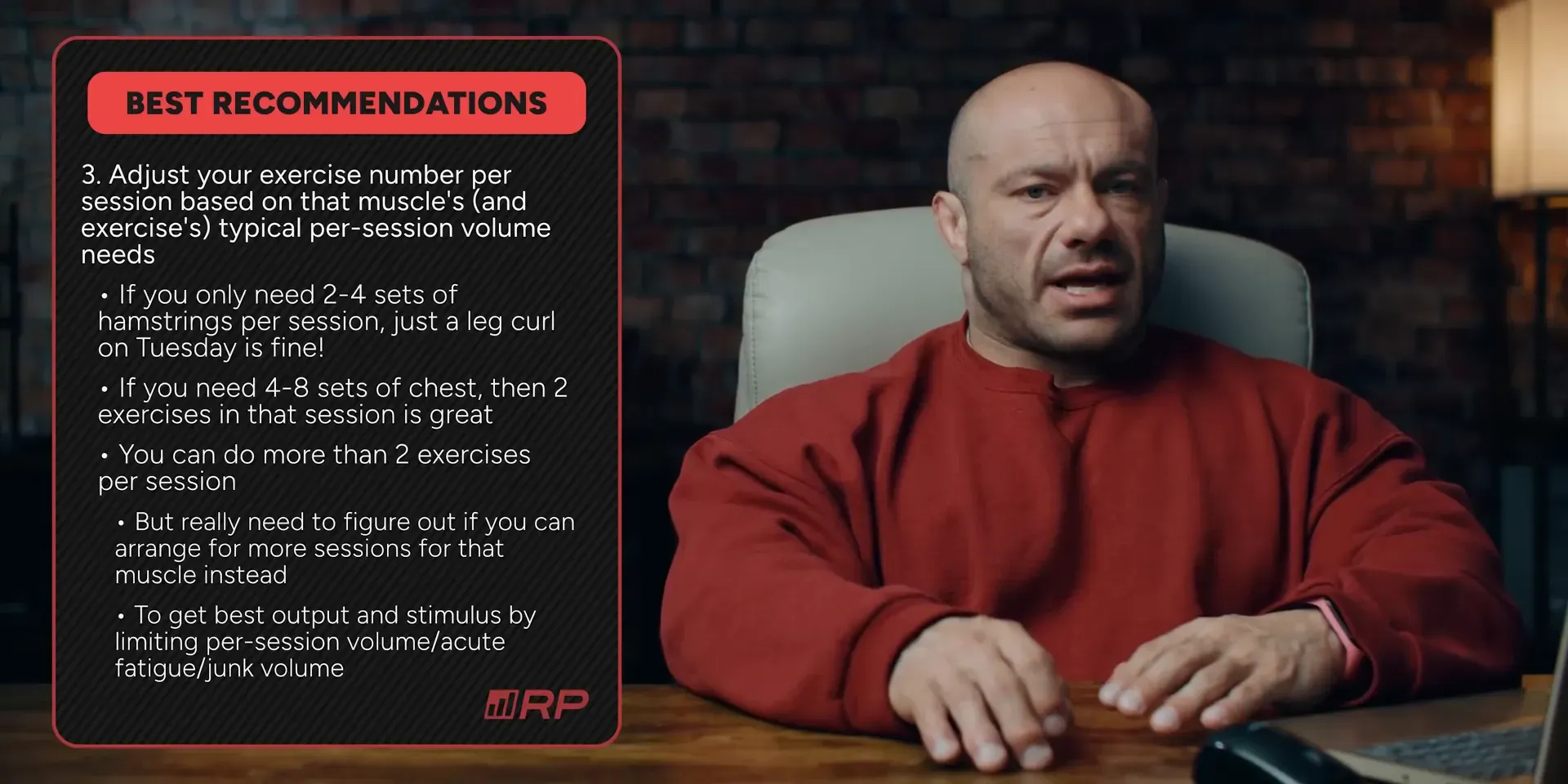
When you think about exercise selection, consider using distributed compounds. These exercises engage multiple muscle groups simultaneously, providing a more efficient workout. For instance, a close grip bench press works both the chest and triceps effectively. This means you can achieve more in less time.
On the other hand, focused compound lifts target a single muscle group. While they have their place, relying solely on them can limit your overall progress. Distributing your efforts across various muscle groups helps to enhance overall muscle growth and strength.
For beginners and intermediates, starting with distributed compounds is a smart choice. This approach allows for more varied training stimuli, making workouts not only effective but also enjoyable.
How Many Sets Should You Perform?

Understanding how many sets to perform is crucial. For most muscle groups, aiming for 4 to 8 working sets per session is ideal. If you're targeting your quads twice a week, focus on getting those sets in without overdoing it.
For example, if you choose two exercises for your quads, each should consist of about 4 sets. This keeps your training effective without leading to burnout or injury. More isn’t always better; quality over quantity is the key.
In more complex muscle groups like the back, you might need to increase the number of sets and exercises accordingly. This ensures that you hit all necessary functions and angles for optimal growth.
Common Mistakes in Exercise Selection
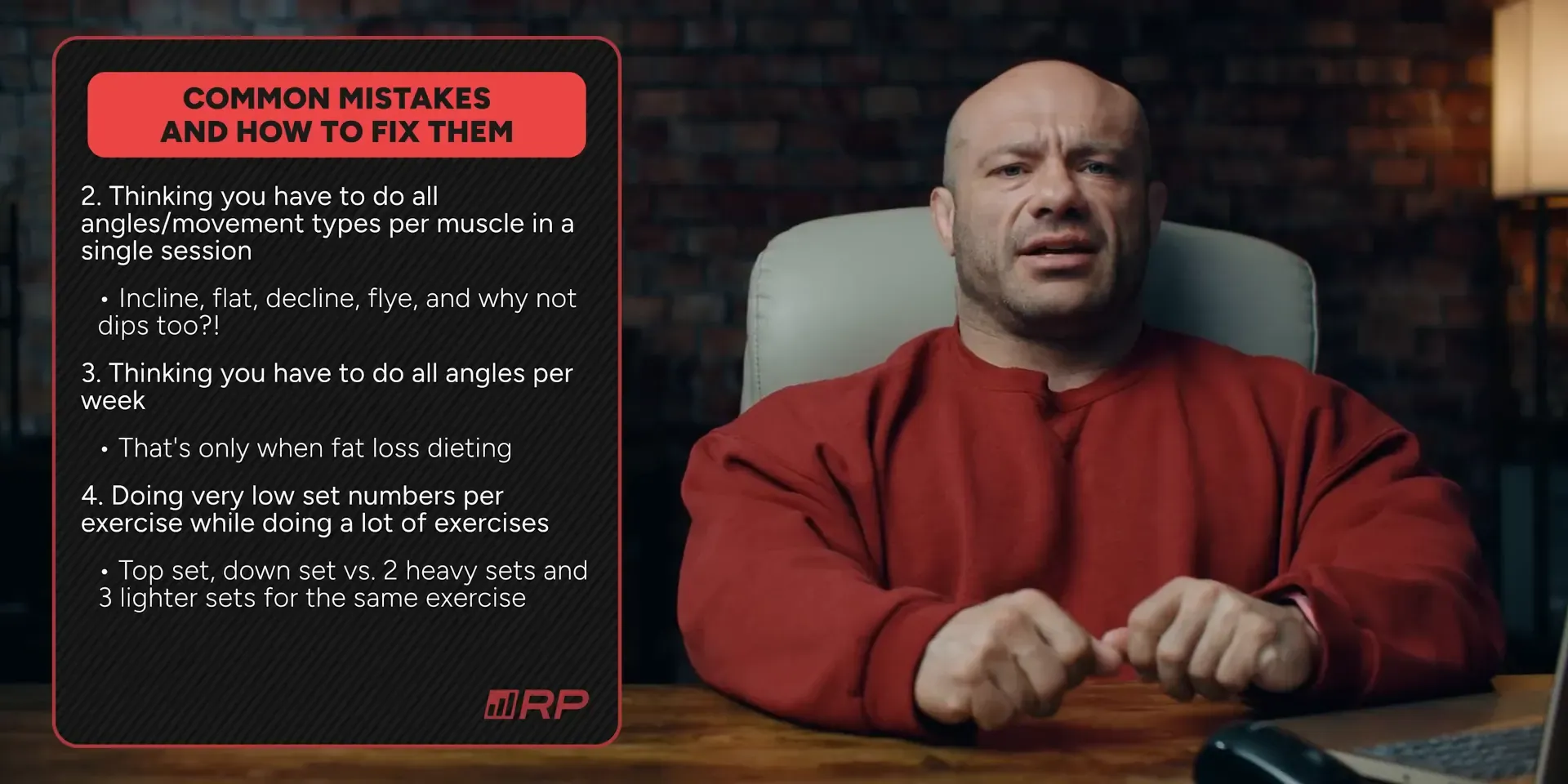
One common mistake is thinking you need to do every exercise available for a single muscle group. This leads to redundancy and wasted time. Instead, focus on a few effective exercises that target the muscle adequately.
Another mistake is not varying the angles enough. For instance, if you're training your chest, it’s not enough to just do flat bench presses. Incorporate incline and decline variations to engage the entire muscle effectively.
Also, many people fall into the trap of doing too many exercises with too few sets. This can result in low overall training volume, which is detrimental to muscle growth. Instead, aim for a good balance of both.
The Myth of One Exercise per Muscle
There’s a persistent myth that you should only perform one exercise per muscle group. While it’s fine to have a primary lift, diversifying your exercises is essential for comprehensive muscle development. This helps target different parts of the muscle and prevents plateaus.
For example, if you only squat for leg training, you might neglect other critical muscle components, such as the hamstrings or glutes. Incorporating exercises like deadlifts or lunges can help address these areas.
Thus, rather than sticking to a single exercise, incorporate a variety for balanced development.
Thinking You Need to Do All Angles
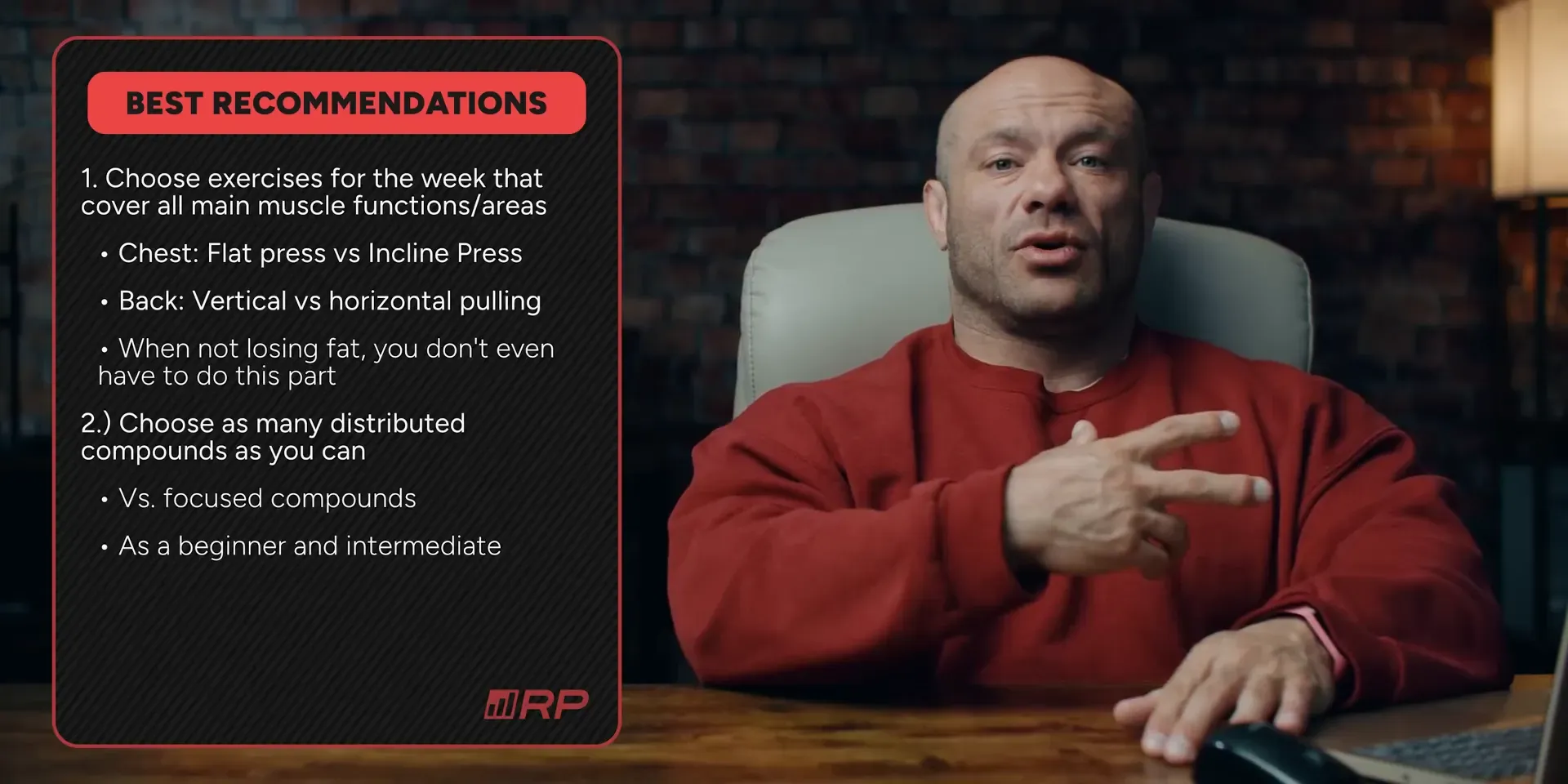
Some lifters believe they need to hit every angle of a muscle in each session. This often leads to overtraining and ineffective workouts. Instead, focus on a couple of key angles per week, allowing for recovery while still promoting growth.
For example, if you train chest twice a week, one session could focus on incline work and the other on flat work. This allows you to hit all necessary angles without exhausting yourself.
Remember, consistency and smart exercise selection are far more important than trying to do everything at once.
Low Set Numbers vs. High Volume
Another common issue is performing too few sets per exercise. Some lifters might only do one or two sets across multiple exercises, thinking they’re keeping the volume low. In reality, this can lead to inadequate stimulus for muscle growth.
Instead, aim for a higher volume with fewer exercises. This ensures that you maintain intensity and focus on quality work. For instance, instead of doing five exercises with one set each, consider three exercises with four sets each.
By concentrating your efforts, you will likely see better results in both strength and muscle size.
Overcomplicating Exercise Choices
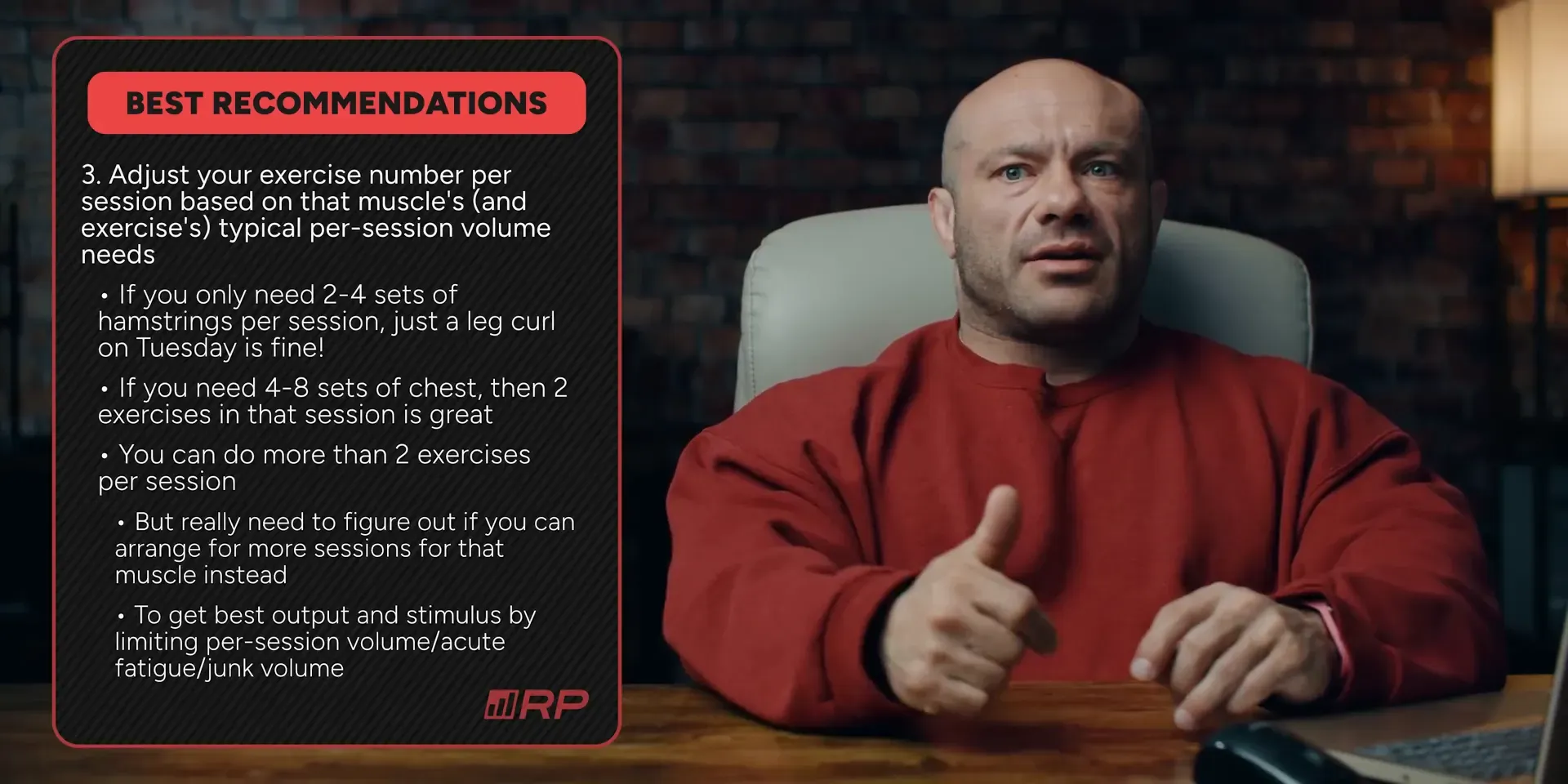
Many lifters overthink their exercise selection. They believe more is better. But this often leads to confusion and inefficiency. You might find yourself doing a multitude of exercises for a single muscle group in one session. This can lead to fatigue without significant gains.
Instead, focus on a few effective movements. For example, when training chest, choose a couple of key exercises. Flat and incline presses can cover a vast range of muscle fibres. You don’t need to hit every angle in one session. This saves time and energy while maximizing growth.
Keep it simple. Select a couple of exercises that you enjoy and that work for you. This maintains your enthusiasm for your workouts. Plus, it gives your muscles the stimulus they need without overwhelming them.
The Role of Functional Anatomy
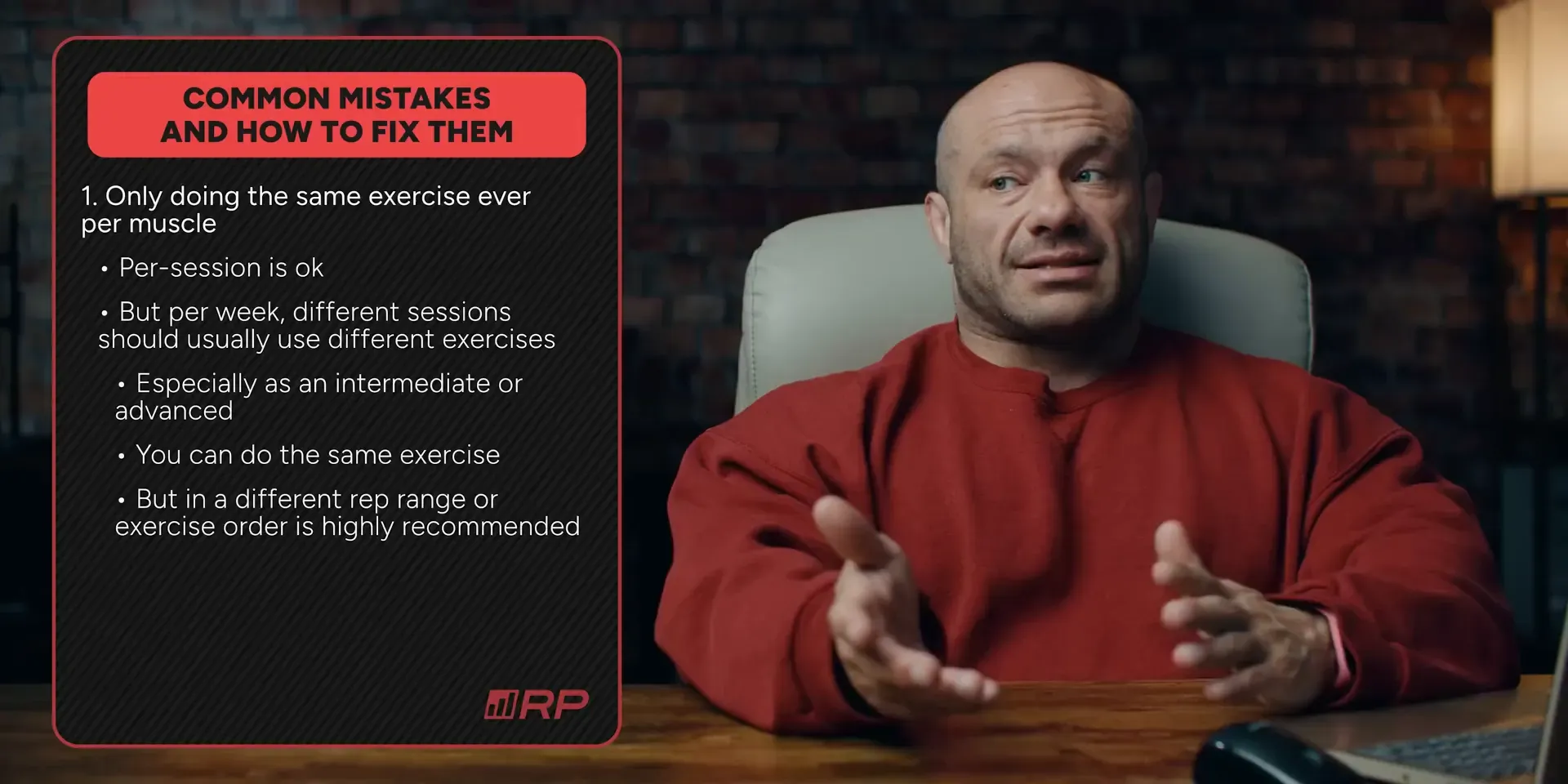
Understanding functional anatomy is crucial for effective training. Every muscle group has unique functions. For instance, the quads and hamstrings both cross two joints. Therefore, they need varied exercises to engage all their components.
For optimal growth, include exercises that target these muscles from different angles. For example, combine leg curls with hip hinges for your hamstrings. This ensures comprehensive activation and growth.
Likewise, your shoulders require attention to all heads: anterior, lateral, and posterior. Each head serves a different function. So, include targeted exercises for each. This helps prevent imbalances and promotes overall shoulder health.
Practical Applications
Exercise Selection:
- Choose 2-3 exercises per muscle group per week
- Aim for 1-2 exercises per muscle group per session
Set Range:
- Perform 4-8 working sets per muscle group per session
- Target 8-16 total sets per muscle group per week
Rotation Schedule:
- Rotate exercises every 4-6 weeks to maintain progress
- Keep 1-2 core exercises constant for tracking improvements
Compound Movements:
- Prioritize distributed compounds for efficiency (e.g., close-grip bench press for chest and triceps)
- Include 1-2 compound movements per workout
Muscle Group Complexity:
- For complex muscles (e.g., back), use up to 3 exercises per session
- For simpler muscles (e.g., biceps), stick to 1-2 exercises
Weekly Frequency:
- Train each muscle group 2-4 times per week
- Allow 48-72 hours between sessions for the same muscle group
For example, for chest training, you might do:
- Monday:
- Flat barbell bench press (4 sets)
- Incline dumbbell press (3 sets)
- Thursday:
- Decline bench press (4 sets)
- Cable flyes (3 sets)
Fact-Check of Key Points
Optimal Exercise Number:
- Dr. Israetel recommends 2-4 exercises for optimal growth
- This aligns with general fitness guidelines, but individual needs may vary
Set Range:
- The article suggests 4-8 working sets per muscle group per session
- While this range is commonly recommended, optimal volume can differ based on factors like training experience and recovery ability
Exercise Rotation:
- Rotating exercises every 4-6 weeks is advised for maintaining progress
- This is a sound principle, but the ideal frequency of rotation may depend on individual response and goals
Compound Movements:
- The emphasis on distributed compounds for efficiency is well-founded
- However, the effectiveness of focused compounds shouldn't be underestimated for specific goals
Muscle Group Complexity:
- The article suggests using more exercises for complex muscle groups like the back
- While this makes sense anatomically, some individuals might achieve optimal growth with fewer, well-chosen exercises
Overall, Dr. Israetel's recommendations are generally in line with established training principles.
However, it's important to note that individual responses to training can vary, and what works best may differ from person to person. The article provides a solid framework, but readers should be encouraged to adjust based on their personal experiences and results.
More Little-Known Tips for Exercise Selection for Muscle Growth
Exercise Pairing:
- Combine complementary exercises for better muscle engagement
- Example: Pair chest press with rows to balance pushing and pulling movements
Time Under Tension:
- Vary the tempo of your exercises to increase muscle stimulation
- Aim for 2-3 seconds on the eccentric (lowering) phase of each rep
Unilateral Training:
- Include single-limb exercises to address muscle imbalances
- Example: Replace barbell lunges with Bulgarian split squats once a week
Exercise Order:
- Perform exercises for lagging muscle groups early in your workout
- This ensures maximum energy and focus for areas needing improvement
Micro-Progressions:
- Use small weight increments (1-2 lbs) for consistent progress
- This approach allows for steady gains without plateauing
Rest-Pause Sets:
- Incorporate brief pauses during sets to increase total volume
- Example: Perform 8 reps, rest 10 seconds, then complete 2-3 more reps
Exercise Variations:
- Slightly modify exercises to target muscles differently
- Example: Use a close grip for bench press to emphasize triceps engagement
Remember, these tips are meant to complement your core training principles. Implement them gradually and pay attention to how your body responds. The key is to find what works best for you while maintaining the fundamental aspects of effective muscle-building routines.
My opinion on muscle growth and exercise selection
I believe in the principle of simplicity when it comes to exercise selection. Overcomplicating your routine with numerous exercises can lead to burnout and confusion. I’ve seen many lifters struggle because they feel the need to do everything at once. I disagree with the idea that you need to hit every angle or every muscle in one session. It’s more effective to focus on a few key movements and ensure you’re performing them well.
Some may argue that more variety leads to better results. While variation is important, I believe that too much can dilute your focus and reduce overall effectiveness. Instead, I advocate for a balanced approach—enough variety to stimulate growth but not so much that you compromise your intensity and enthusiasm.
For more details, check out our guidelines on changing exercises for growth. Briefly, like many experts, we've found that 2-3 exercises per muscle group is probably all you need to optimize hypertrophy.
Concluding on muscle growth and exercise selection
In conclusion, selecting the right number of exercises is crucial for effective muscle growth. Focus on fewer exercises, understand your muscles, and maintain a balance between variation and consistency. This approach will lead to better results without overwhelming you.
If you want to simplify your training and ensure you're on the right track, consider the Dr. Muscle app. It automates your workout planning and helps you stay focused on your goals. You can check it out at Dr. Muscle. It’s a game changer for anyone serious about their fitness journey.
FAQ
How many exercises should I do for each muscle group?
Generally, 1-2 exercises per session are sufficient for most muscle groups. If you’re targeting a complex muscle group, you may need up to 3 exercises.
Can I do the same exercises every week?
Yes, but it’s advisable to vary your rep ranges and weights. This keeps your muscles engaged and helps prevent plateaus.
Is it better to do more sets or more exercises?
Focusing on fewer exercises with more sets is often more effective. This allows for greater intensity and better muscle engagement.
How do I prevent workout monotony?
Rotate exercises every few weeks. This keeps your workouts fresh and ensures your muscles continue to adapt.
Should I change my exercises if I’m not seeing results?
If you’re not seeing results, consider adjusting your rep ranges, weights, or even your exercise selection. It's important to continually challenge your muscles.
